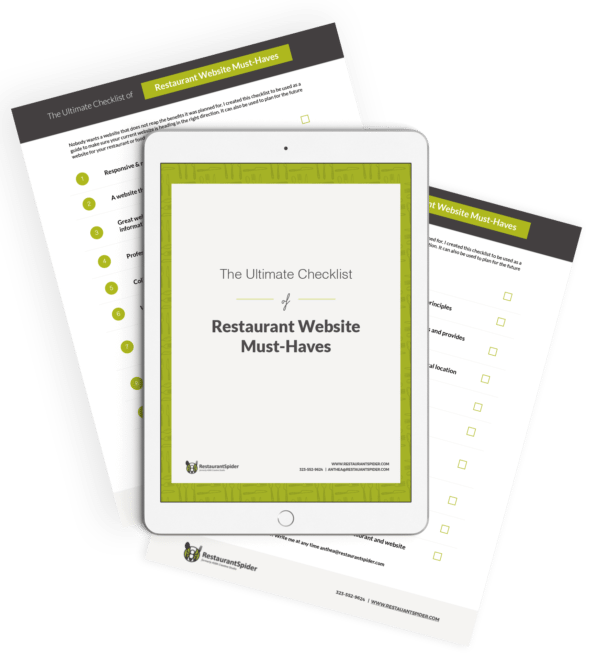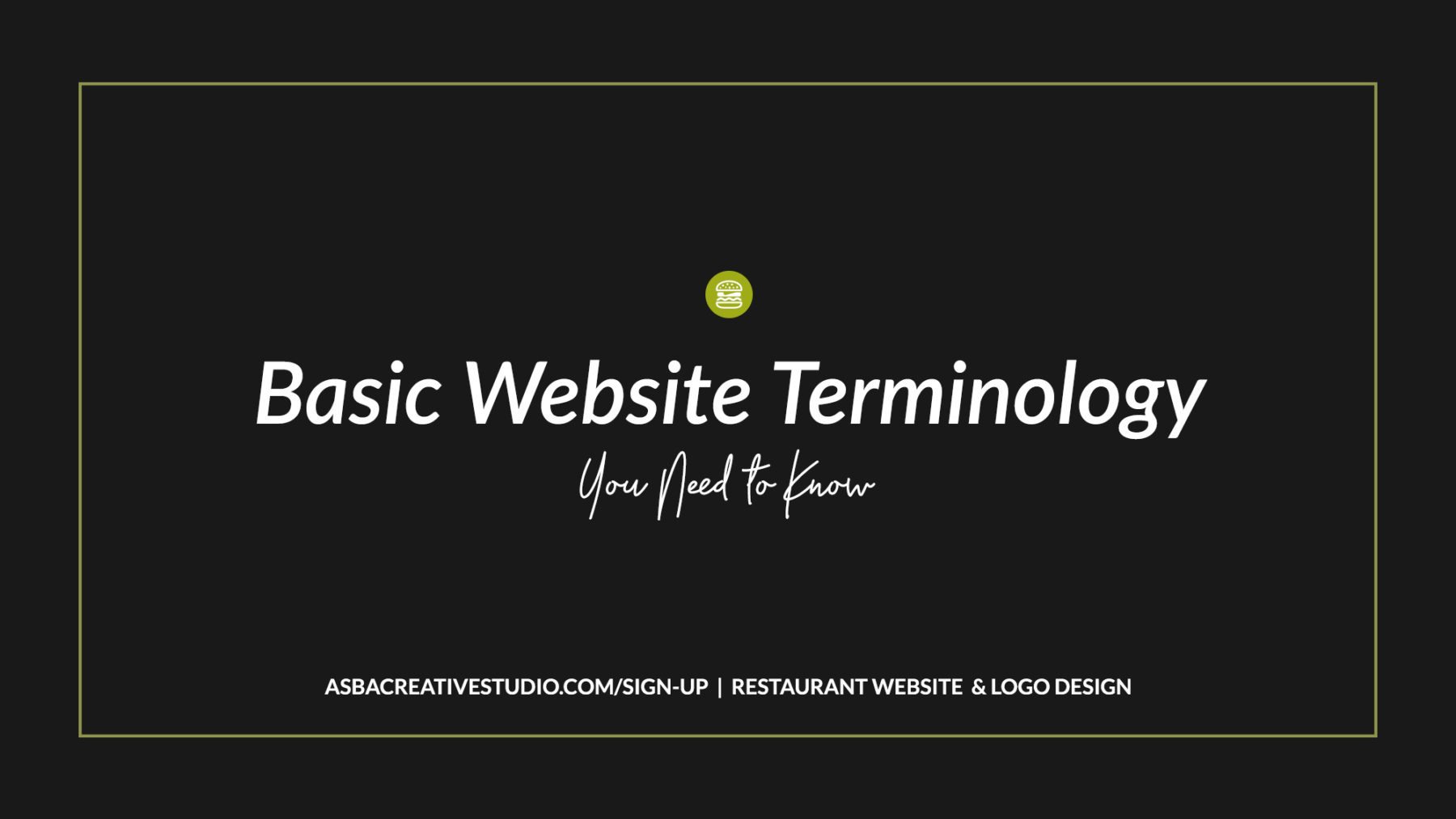
by restaurantspider | Aug 30, 2017 | Website Tips
Do you feel like you’re stuck in the stone age when a conversation arises regarding websites? Do you feel like your designer is speaking Greek when you talk to them?
Well, I’ve got you covered. I have created a list of some basic website terminology that could possibly save you when you’re in one those conversations. The internet is has become a thing of the norm so it is very helpful if you know at least a few things about websites to get up with the times.
HTML (Hypertext Markup Language)
HTML is basically the language used to create a website. Think of HTML as the frame of your house.
CSS (Cascading Style Sheets)
CSS is a type of language used to create the look and feel of a website. Think of CSS as the elements used to beautify your house like the paint, the windows, the decor etc.
WordPress
Wordpress is an easy-to use content management system (CMS) used for building websites and blogs. A content management system is basically a software used to create and manage website content. The CMS itself is free to use but you would need hosting to use WordPress on the web. Please note that there are two types of ways to use WordPress to create a website – wordpress.com and wordpress.org. WordPress.com websites are hosted by WordPress and wordpress.org is self-hosted. If you want an easily customizable website that you can control, a wordpress.org self-hosted website is what you need.
Responsive Website
A responsive website is a single website that adjusts seamlessly to any device screen size. With a responsive website, there is no need for pinching and zooming to make out the content of the website because the website is developed to look great on all screen sizes.
Website Header
A website header is the top part of your website that usually contains your logo, tagline, social media and other information regarding your brand. It usually sits on top of your navigation and at times acts as a container for your navigation. It is also usually the same on every page.
Navigation Bar
A navigation is the part of a website that helps you go to the different sections of your website. It is the most important part of your website and should be very simple and easy to use.
Call to Action
A call to action is a clickable element (image, button or text) that is used to drive traffic to a specific web page.
Hero Image
A hero image is a large prominent banner located under the header on the homepage of your website. It is usually the first graphic on the page and is used to capture your audience.
Slider
A slider is basically rotating images on a website that is usually placed at the top of a website in place of the hero image.
Full-Width Website
A full-width website is a website that spans across the width of the page.
Full-Screen Website
A full-screen website takes the entire device screen on every device. A part of a website like a hero image can take the full screen and it usually has an arrow or link that takes you to a different page of the website.
Boxed website
A boxed website has a set width and therefore does not fit the entire screen. It has space to the left and right of the website and is usually a solid color.
Website Content
Website content is all the information you need to provide a designer to design your website. The information includes graphics, images, and text.
Landing Page
A landing page is a single web page with a goal of persuading users to take action. It is usually used to target audiences for one specific product.
Page vs Post
A page is basically a static stand alone web document on your website that provides information. Posts are basically web pages that make up a blog. Posts are usually updates and news on a website. Posts help greatly to drive traffic to your pages because blogging creates custom content for your website which is great for search engines.
WordPress Plugins
Wordpress Plugins are used to add new functionality and features to a WordPress website. WordPress itself is very basic and in order to be more customizable, it needs the help of plugins.
Keywords
Keywords are words or phrases that are added to your website to help drive traffic from targeted audiences. In the keyword world, phrases work better than single words because they reduce irrelevant matches.
SEO (Search Engine Optimization)
SEO is a method used to drive traffic to your website by making the content of the website searchable with the use of keywords, image titles, and links.
SEM (Search Engine Marketing)
SEM is a combined method to drive traffic to your website from various sources like Google AdWords, Bing ads, Facebook ads, banner ads etc.
Registrar
A registrar is a company you use to register your domain name.
Domain Name
Your domain name is the name users will type into the browser to access your website. They can end with .com, .net, .org, .co etc. For example “asbacreativestudio.com” is a domain name.
Hosting
Hosting is storing your web files in a location where it can be accessed on the internet. In order to have a website, you must have hosting which usually requires a monthly payment to your hosting company.
MockUp
A mockup is the undeveloped design of a website that is shown to a client to preview the design of the website before it is developed.
Opt-In
An opt-in is a form or button on a website used to collect email addresses in exchange for something of value.
Well, there you have it. I hope this post helps you carry on conversations with your designer or people in general who are web savvy. If you have any other website terminology you need to decipher, comment below and I’ll help answer your questions!
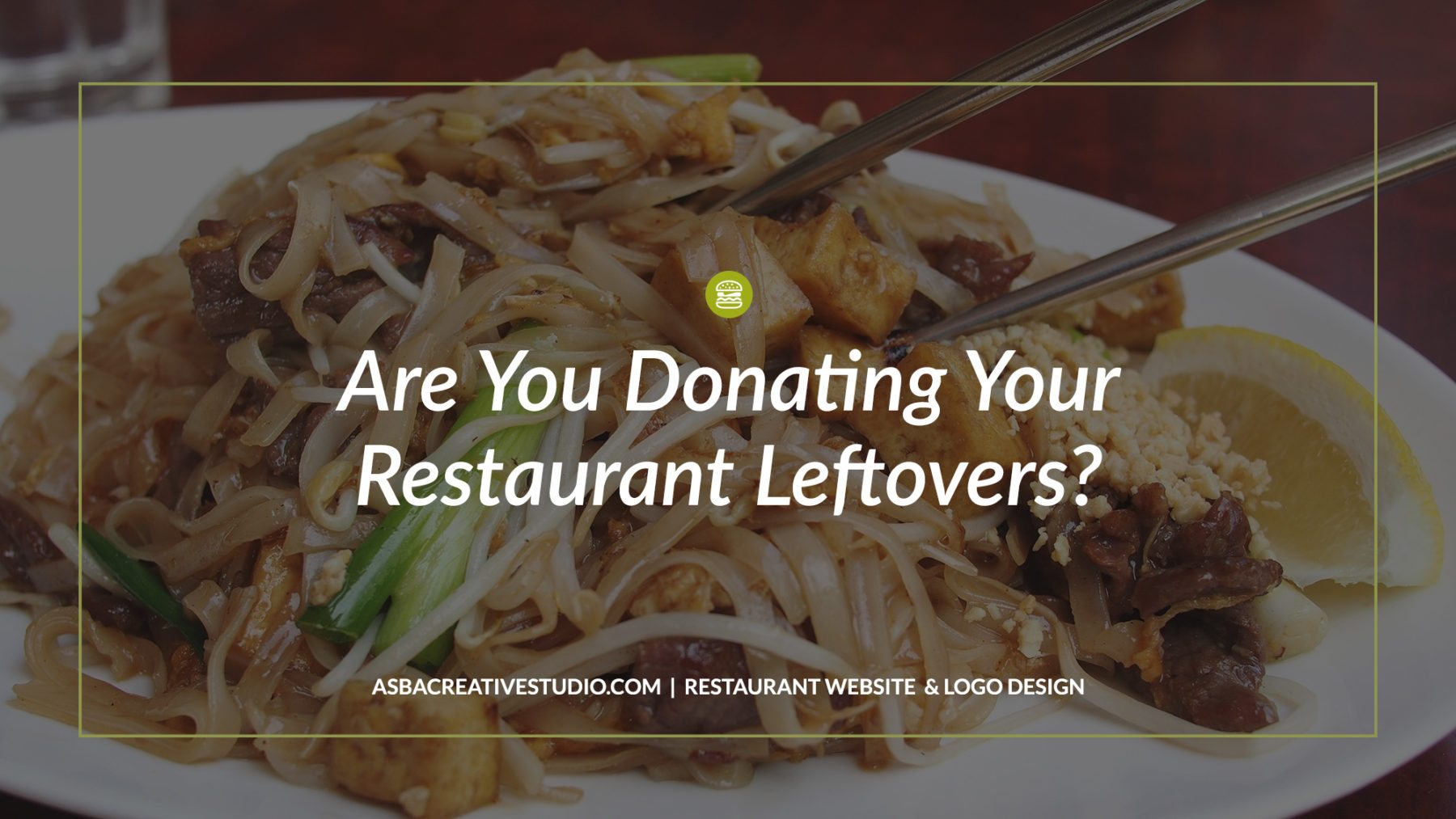
by restaurantspider | Aug 23, 2017 | Restaurant Tips
Every time I eat at a restaurant, I can’t help but think of all the food that could possibly go to waste in a day. This got me wondering—do restaurants actually donate food, want to donate food or even know how to donate food? Does all this good food end up in a landfill? With a little bit of research, I found out that it is possible but sadly, there aren’t many restaurants participating in these programs.
In an article by David Lazarus in the LA Times, regarding an Orange County program that makes donating leftover food easier, there was a quote by a restaurant owner that really caught my attention.
“Most of us live by the credo ‘When in doubt, throw it out,'” said Mike Learakos, owner of Katella Grill in Orange. “There’s a big fear of liability if you donate leftover food.“
It became known to me in the article above and another article, Restaurants Officially Have No Excuse Not To Donate Leftover Food by Eleanor Goldberg of the Huffpost that there really is a huge fear among many restaurant owners of getting sued by the recipient if they get sick. Well, it’s great to know that this stigma is not true.
Restaurants Are Protected When Donating Restaurant Leftovers
Within both of these articles, I learned that there is a federal law that protects food donors from being sued in case of any issues regarding recipients getting sick or hurt from ingested food. It’s called the Bill Emerson Good Samaritan Food Donation Act and it was passed by President Clinton on October 1, 1996. The law protects good faith food donors from civil and criminal liability that later causes harm to the recipient. The law protects food donors, including individuals and non-profit feeding programs.
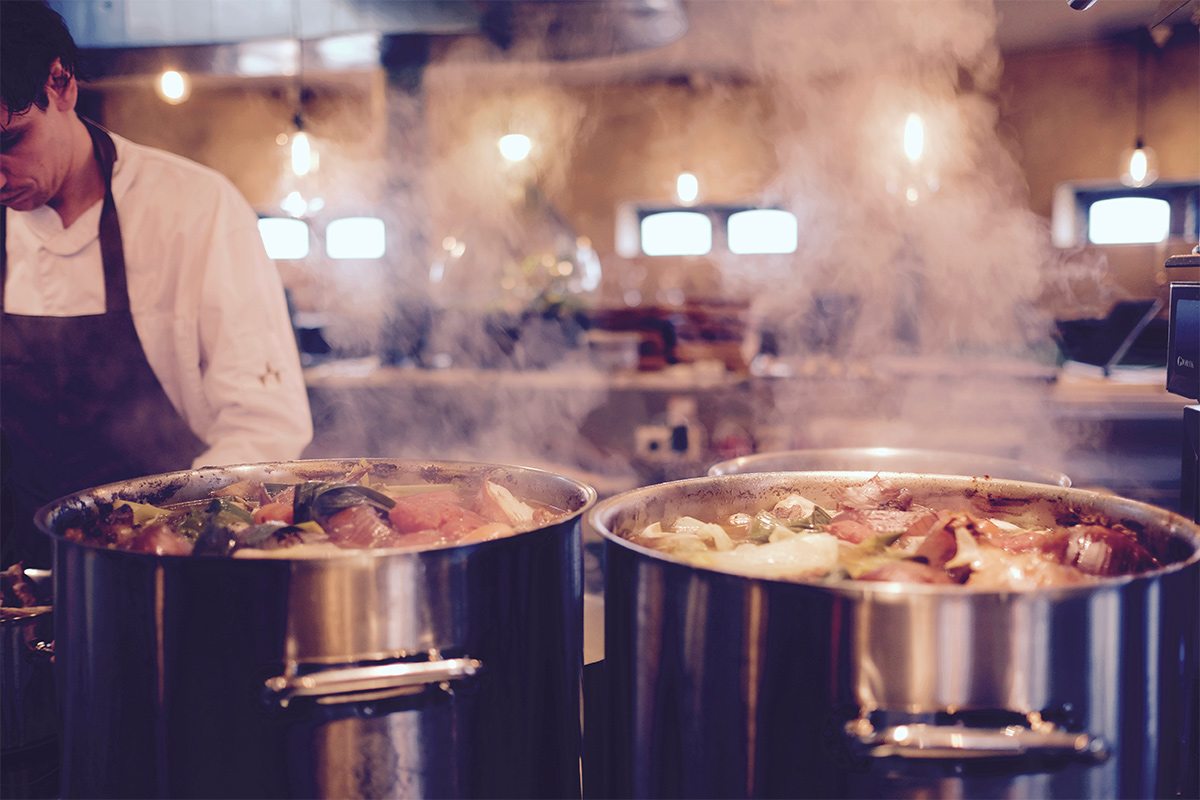
According to HuffPost, a single restaurant in the U.S. wastes about a whopping 100,000 pounds of food a year. Yup. I bet you would agree that it’s a pretty big number. Well, in hopes of encouraging restaurant owners to donate any excess food, I have made it easy and created a list of organizations that provide details on how to become a donor.
https://www.rescuingleftovercuisine.org/
https://www.wastenotoc.org
https://412foodrescue.org
http://www.campuskitchens.org/
http://www.foodfinders.org/
https://www.lafoodbank.org/
https://www.wedontwaste.org/
http://www.chefsendhunger.org/
https://www.re-plate.org
There are so many people in our communities, adults and children alike, that are starving because for one way or another cannot afford to buy food. Donating your restaurant leftovers is definitely a way to give back. Start donating today!
Have you donated any leftover food yet? Comment below on your experience with the donation process.
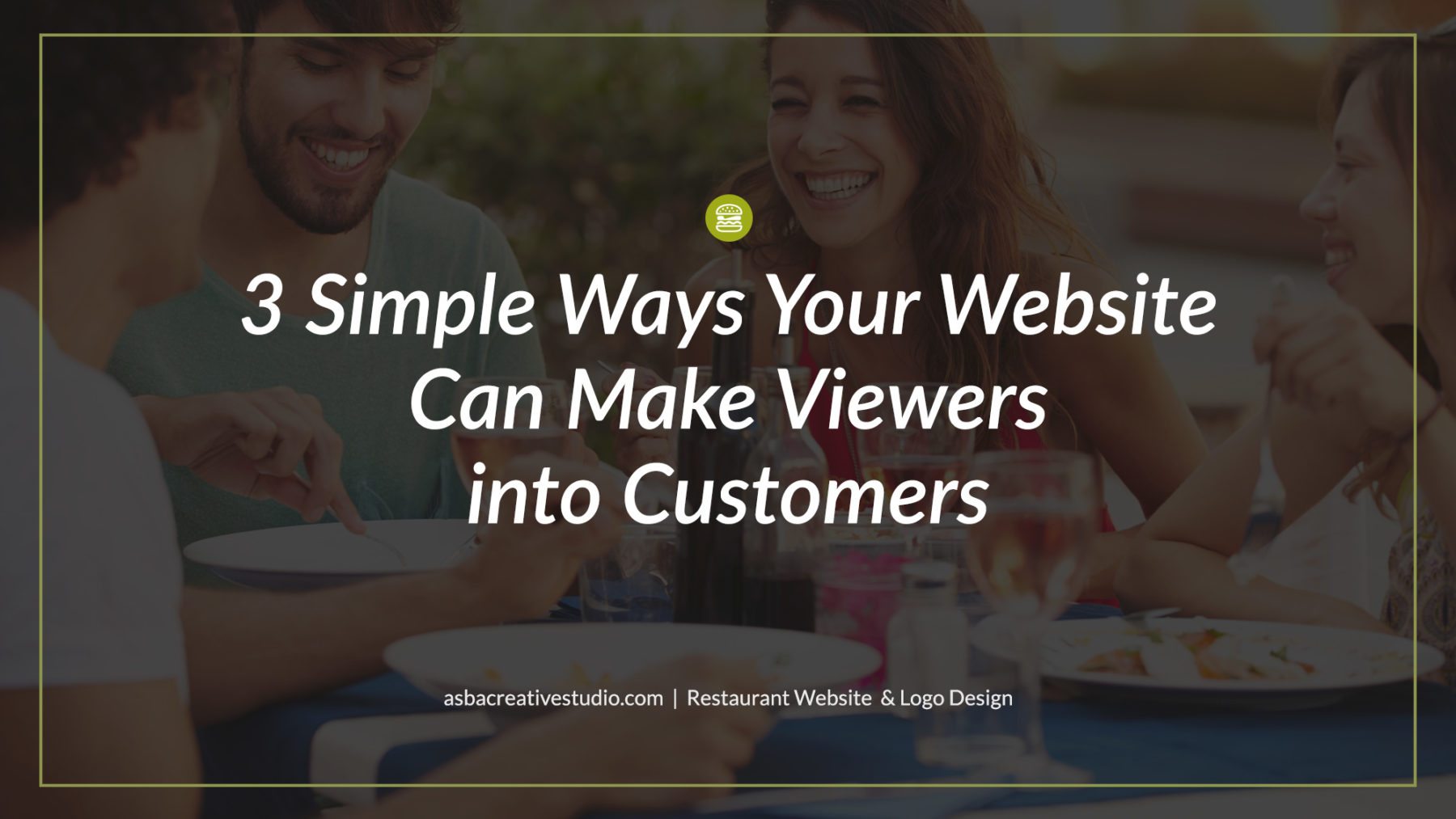
by restaurantspider | Aug 17, 2017 | Website Tips
When you have a website, one of your goals is for it to be an extension of you as a restaurant and a restaurant owner. It needs to serve as a platform for you to give customers a feel of your food and your establishment, a place for interaction between the customer and your restaurant and a place to help customers to find you. Customers want to feel welcome so it is great to provide tools on your website that create this atmosphere. Having a website is one of the top restaurant marketing ideas, and a key tool in your restaurant marketing plan.
By the end of this post, you will learn 3 simple ways to improve your website and restaurant marketing with your website to enhance a welcoming atmosphere to in turn increase traffic to your restaurant.
1. Clear & Easy to Find Contact Information
I have had a few run-ins with restaurant websites where I simply cannot find basic contact information. When this happens, I either check another source, if I really need to go to this restaurant or I leave the website and find another place. The second scenario is the most popular and that’s not a good thing. Make sure phone number or contact page link is placed in areas of your website that customers cannot miss. Your contact page link should be placed preferably in the navigation which is the first place a customer looks when they need to navigate your website. I will strongly advise that your phone number and address should be in plain text so it is clickable on a mobile device. Nowadays, there seems to be an underlying motto of “if it’s not easy, I don’t want it” so don’t get caught in this web. In this same thought, make sure your map is an embedded Google map, not an image so customers can easily map out their journey right from your website. Adding your social media profile page links is also a great way to add to the ways a customer can contact you.
Example 1
The Bancroft clearly displays contact information prominently in navigation and on the home page of their website.
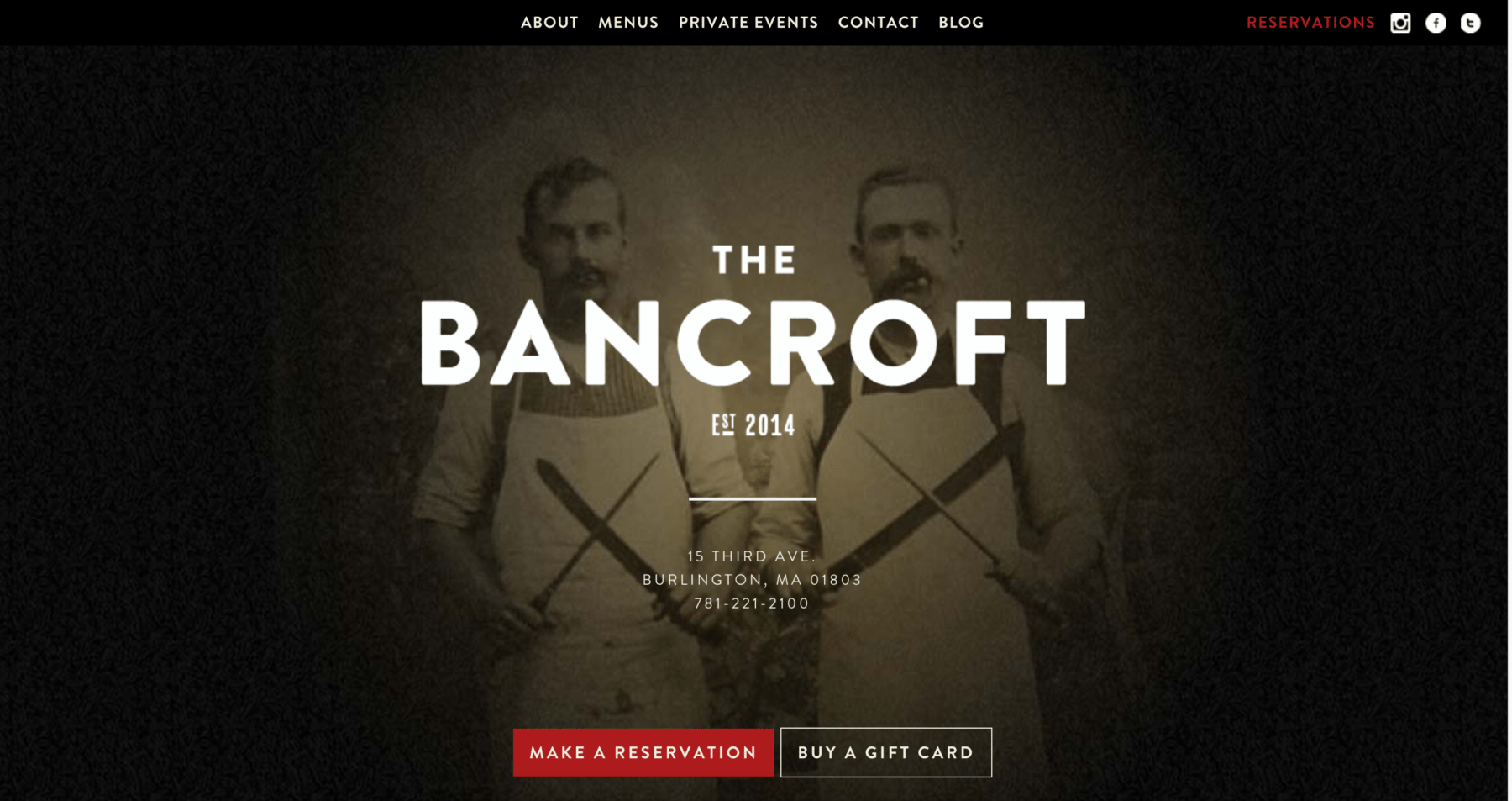
Example 2
At the bottom of every page, The Eddy displays a map and all contact information
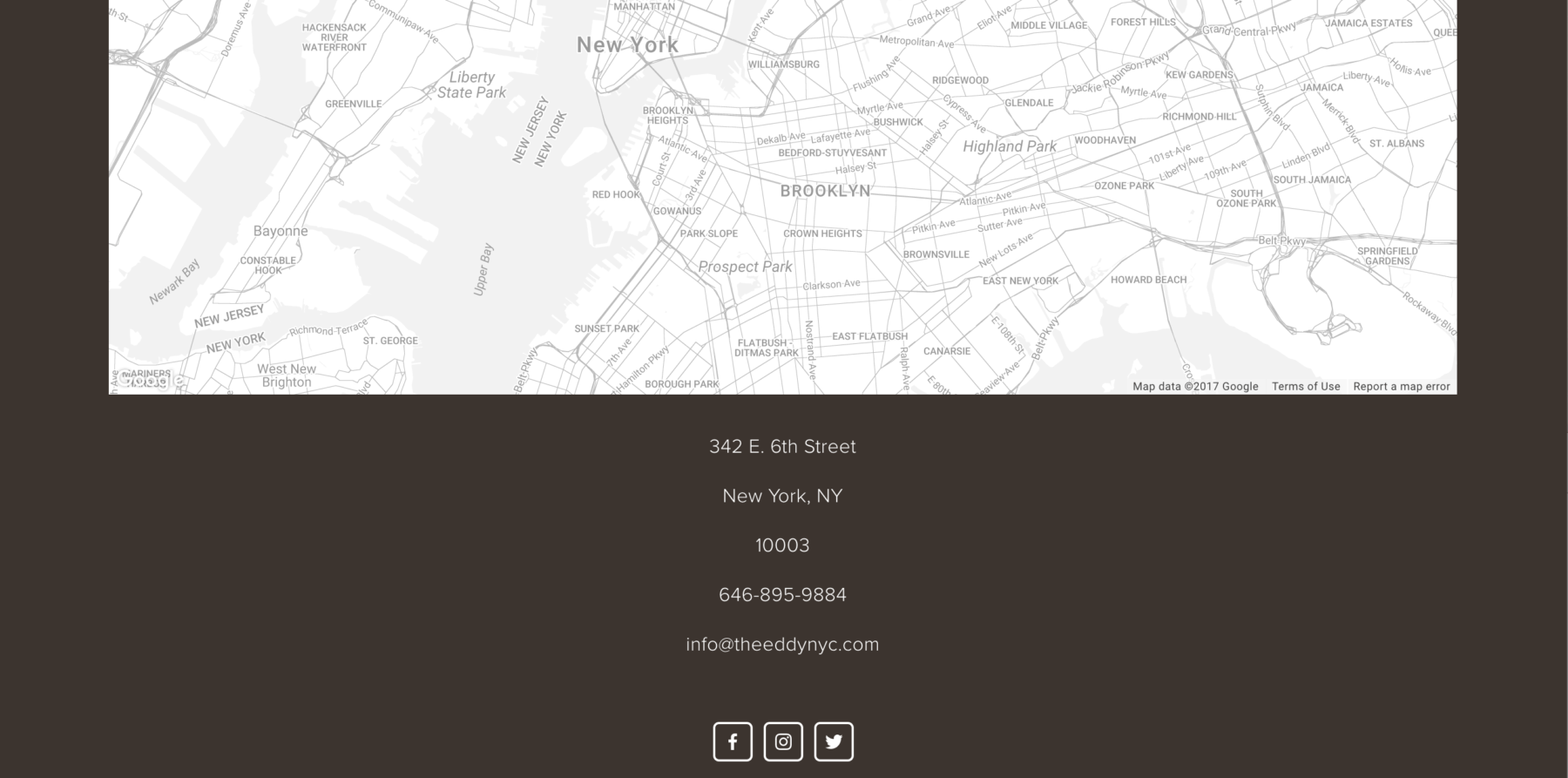
In summary, customers need to know where you’re located and how to contact you. Don’t hide it.
2. Customer Reviews / Testimonials
Reviews and testimonials are a great way to engage customers but it, for some reason, tends to be one of the overlooked restaurant marketing ideas when creating a website. When I’m about to place an order of pad thai (my favorite Thai dish) from a Thai food restaurant I’ve never been to, I love to read reviews on customers’ experiences with the pad thai and how quickly it’s delivered. Once those two areas check off with great results, I’m sold but if I am unable to find this info, I rarely order from there. As humans, we love to get recommendations on things other people have used and are happy with because it reassures us that we are making the right decision. Listing reviews from customers on your website is a great way to push people to want to eat at your restaurant. Yelp, Google, Trip Advisor, Zomato and others are great platforms to get your customers talking about you. Get a business profile set up through these review platforms and keep it up to date. Grab your best reviews from there and place them on one of the pages of your website to entice your customers. As simple as that. Doing this is not only a great way to bring people in but it also serves as a way of knowing where you are doing well and where you are not. There should always be room for improvement.
Example 1
Quay does a great job by showing a slide show of customer reviews on their about page.
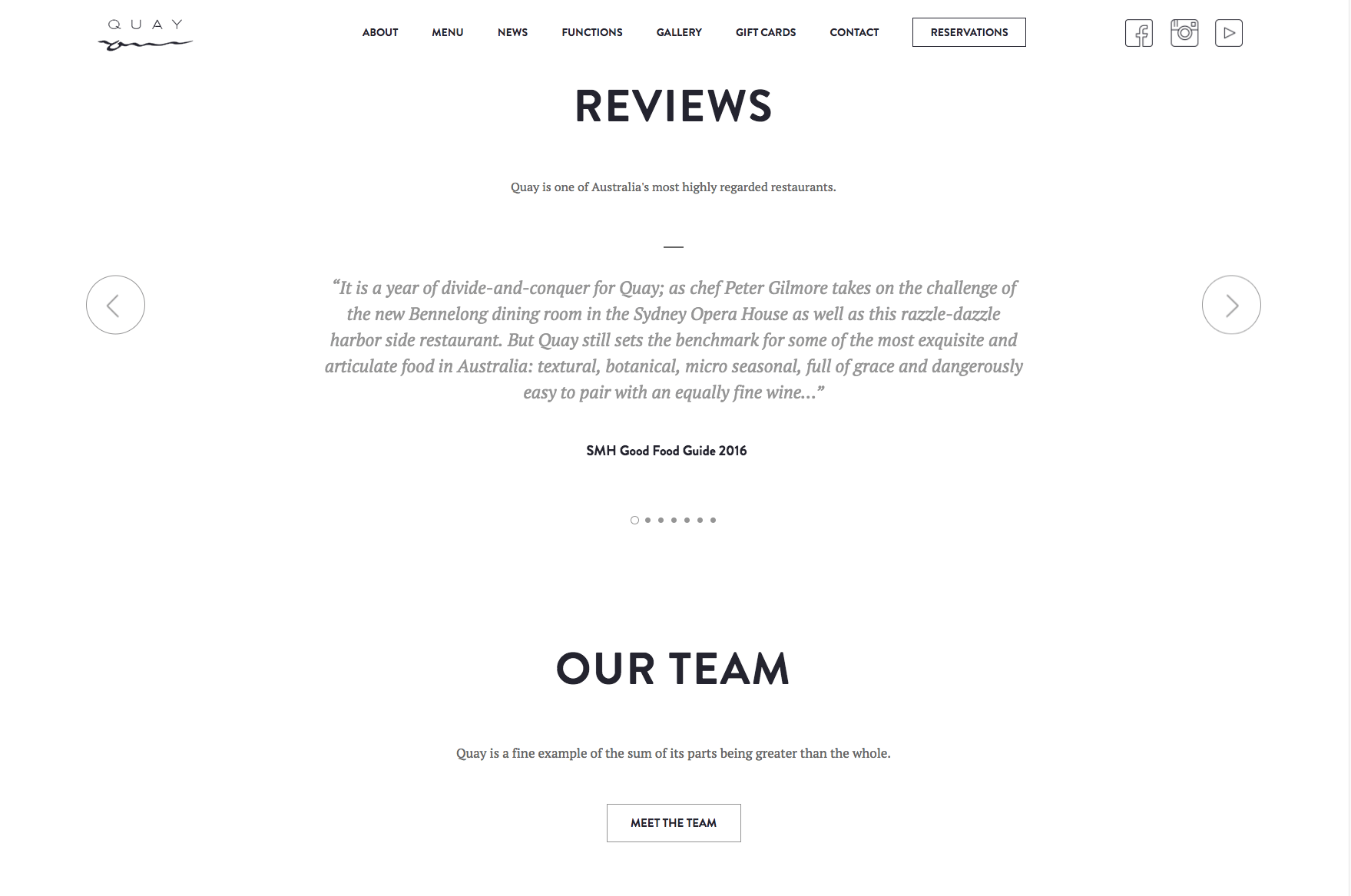
Example 2
Heres Looking at you shows a link to a review by LA Times right on the home page of their website. Since this review is of great standing, just the one review says it all.

In summary, flaunt the great things people have to say about your restaurant. It sells!
3. Opt-In Forms
I rarely see opt-in forms on independent restaurant websites but it is a great tool in the restaurant marketing plan and is very easy to start. An opt-in form is a simple form with an email and/or name field to capture email addresses and in return provide them with something of value. Your email list provides you with a large list of people interested in the food and culture of your restaurant. You can send menu updates, events, promotions like a “Free burger on your birthday”, “Taco Tuesday”, “Milkshake Thursday”, whatever, to give subscribers an urge to come in. You have to note that when one person comes to your restaurant, they rarely come alone… Chi-Ching. Your opt-in form can be placed at the top of your website, on your contact page, in the footer of your website, in a pop-up box, in a blog post, at the end of a blog post or even on every page. Some of the best choices for setting this up would be email marketing platforms like Mailchimp, Mailerlite, Mad Mimi, InfusionSoft, just to mention a few. These platforms include many other email marketing features that can add more value to your online presence. To save you money starting to grow your email list with email marketing, Mailchimp offers a free service with up to 2000 subscribers and Mailerlite (who I am affiliated with and use on my own website) also free with up to 1000 subscribers.
Example 1
Here is an example of a pop-in opt-in form on Lemonade’s website. On this website, it pops up right when you enter the website but it is possible to adjust the timing, in your email marketing platform, of when the form pops up after a customer goes to the website.
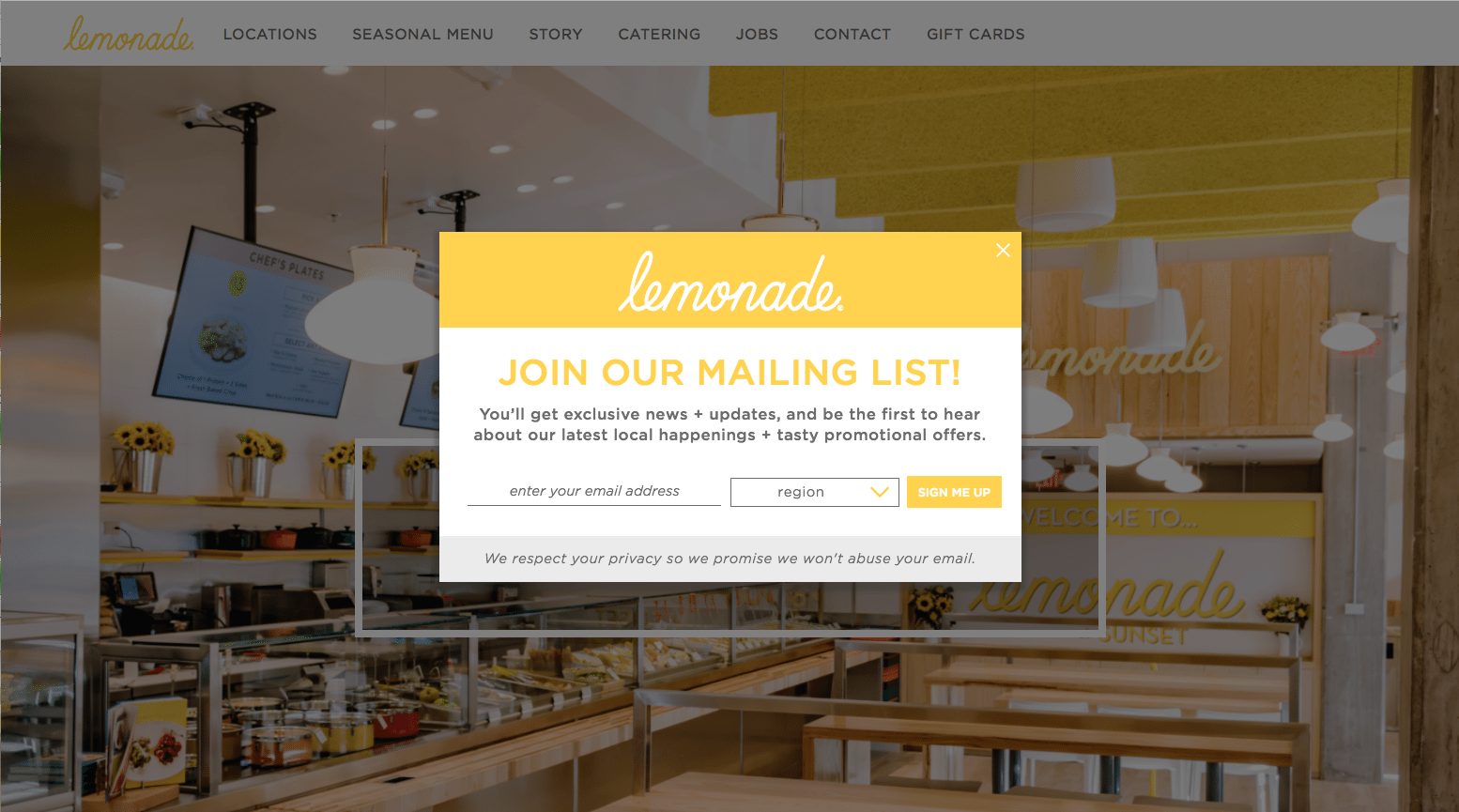
Example 2
Here is an example of Red Bird’s simple opt-in form in the footer of the website of every page.

In summary, an opt-in form is a small and valuable addition to your website that helps to increase your reach and keep your customers up to date. Check out the opt-in form I have here on this site offering Editable Restaurant menus you can download and use in your restaurant marketing plan.
So there it is! I hope this post inspires you to make just a few tweaks to your website to enhance and take it a step further to attracting more customers to your restaurant.
Comment below to let me know how this goes 🙂
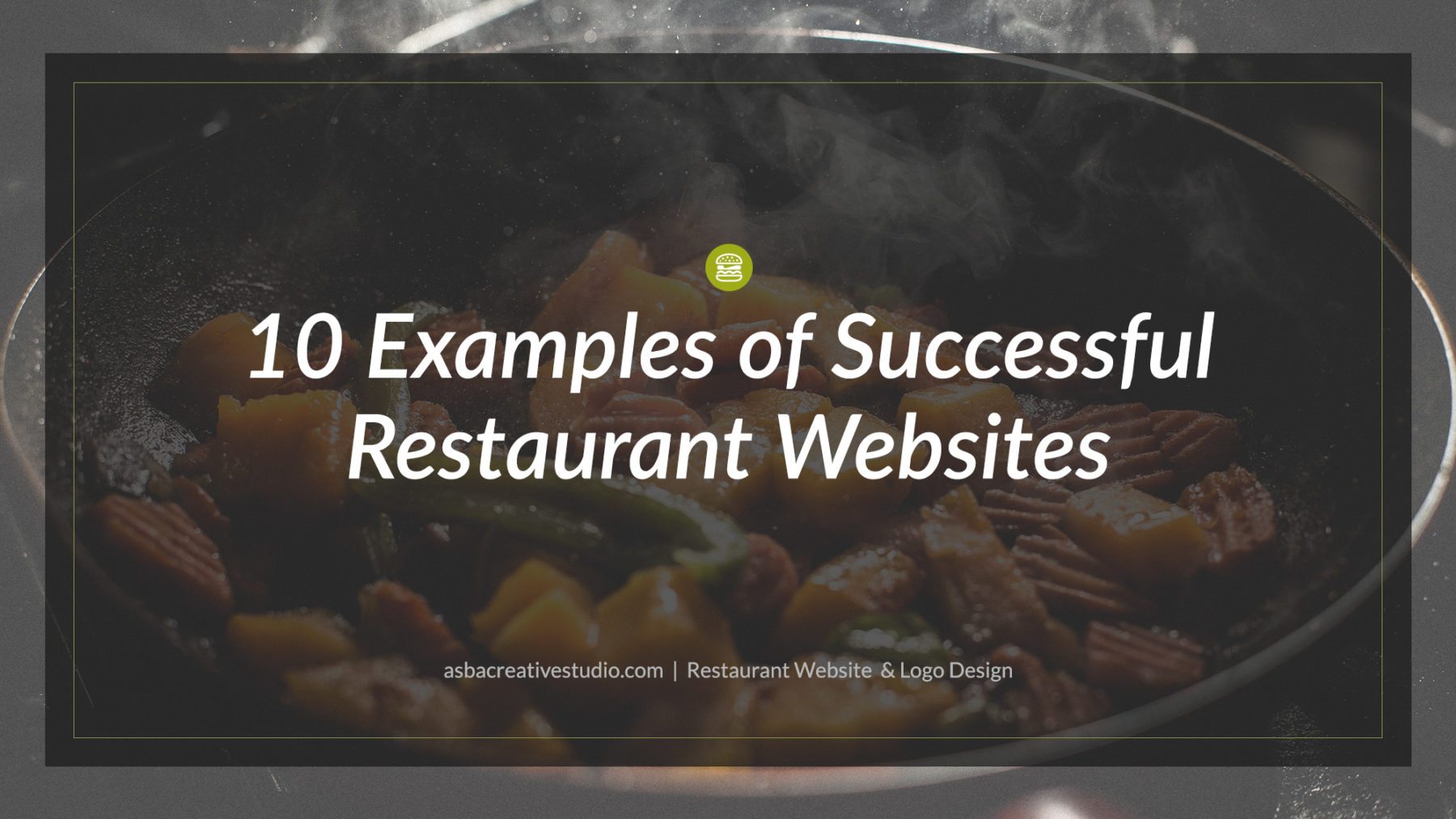
by restaurantspider | Aug 10, 2017 | Website Tips
As a website designer, I love to look at beautifully designed websites to get inspiration for my next project and get familiar with what’s out there. The worst thing is to get behind on the current design trends. Let me ask you this. When you go to a restaurant website that looks really good and in addition to that, has all the information you need to make it there and eat. You feel great right? Well here are 10 restaurant websites that give me that great feeling. They inspire me and I hope they inspire you too.
Let’s dive in.
1. Catch La – catchrestaurants.com/catchla
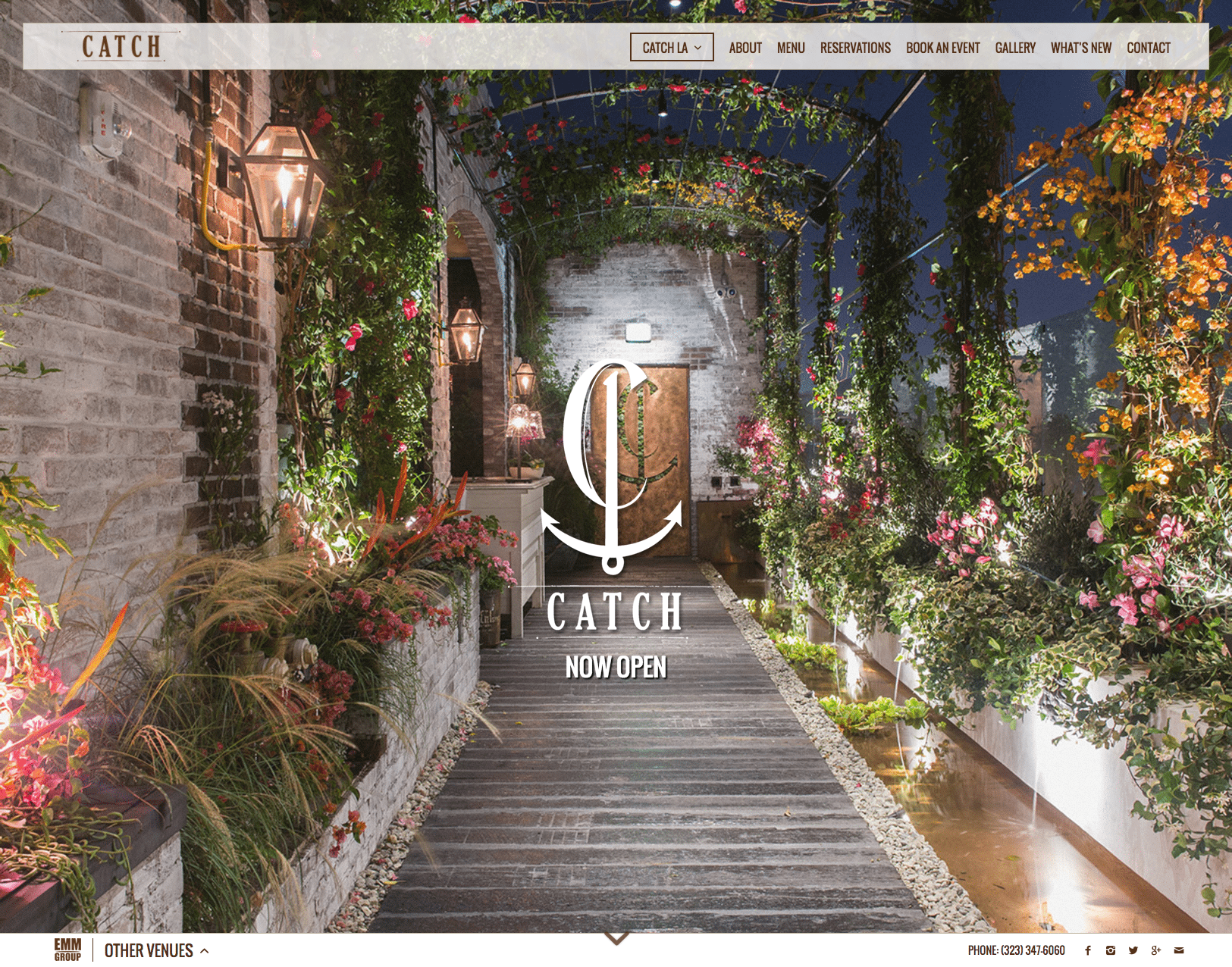
To start off, here is the website for Catch LA. I love this website because it starts off by bringing the customer into their restaurant by using an inviting image of the pathway to their door. The professionally taken photographs show bits and pieces of the restaurant itself, surroundings, food, and beverages. This gives the customer sense of what the restaurant is about. As you may know by now, I have a pet peeve for downloadable menus due to its negative effect on SEO (Search Engine Optimization) but I should say that this section of the website is designed and organized in such a way that it each menu is easily accessed to download. The website also gives customers all the information they need to contact and dine with them.
2. Republique – http://republiquela.com

Ooh, this is another restaurant website I love. Its color combination of the brown, beige and blue for the buttons work perfectly well to put your mind and belly at ease when reviewing the website. Here, the photography instantly tells a story about the restaurant’s breakfast, lunch and dinner menus and then continues to bring you in by showing images that represent each menu type. In addition, these images link to their respective menus. Republique promotes their use of social media by adding icons that link to their respective pages and show off their Instagram photos to encourage the community to talk about their food. I also like how they show important links like their join the team, gift cards, mailing list, and reservations right at the top of every page. Overall the look of this website makes you want to visit it to experience the culture and food.
3. Lukshon – http://lukshon.com
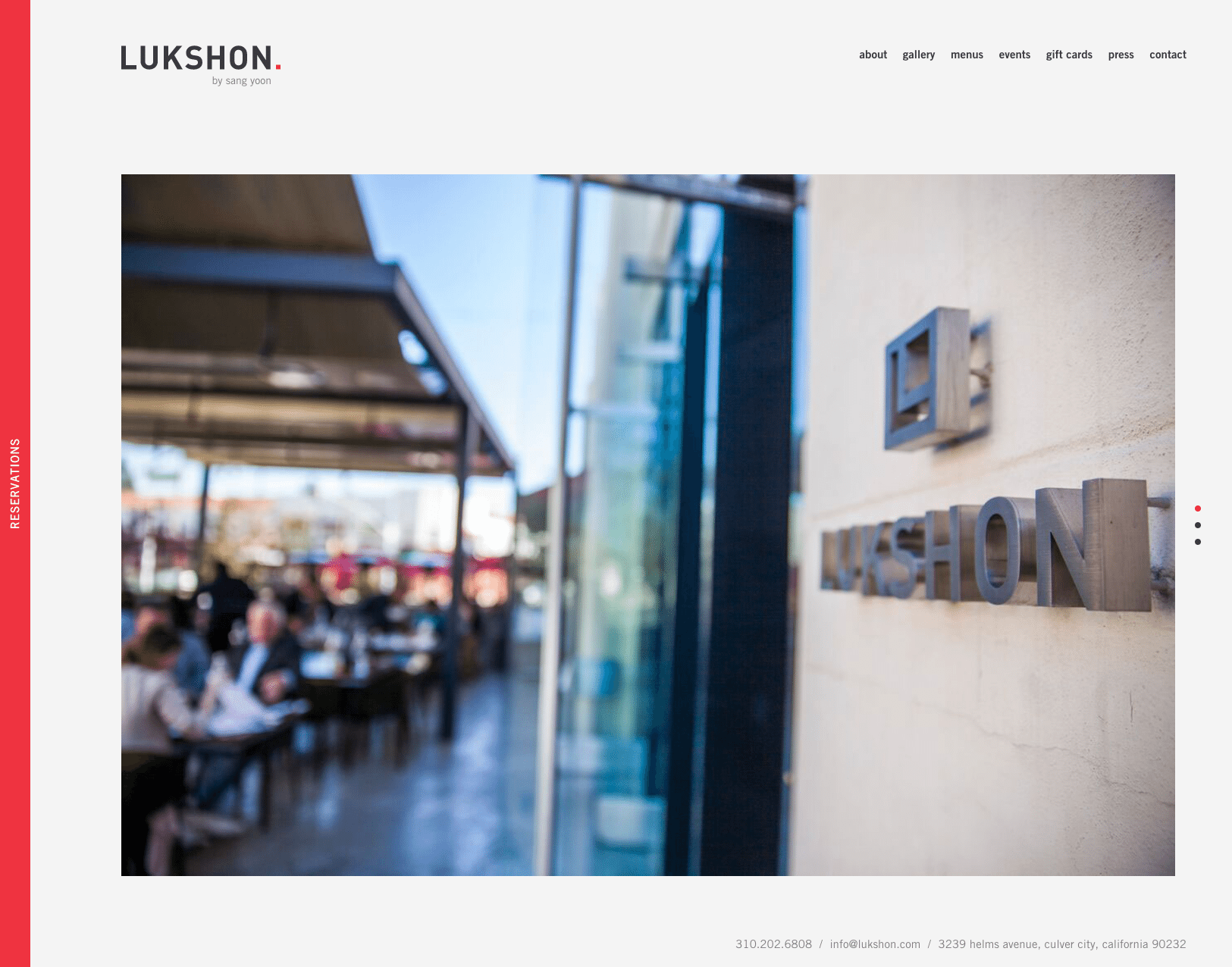
Now this one-page website for Lukshon is just simply modern and beautiful. It is a fullscreen website so it takes up the space of the entire screen when viewing it. What excites me, is their reservations tab. The red color draws your attention as intended and reiterates the fact that they are trying to encourage customers to book a table. The functionality is just plain “cool” as it slides from the left side of the screen and takes the full screen when opened. The image menu here is a deduction because it has a low resolution, is hard to read and bad for SEO (Search Engine Optimization) but their photos are very professional with a style matches the modern website feel. Lukshon also integrates their social media on the website as a good way for the community to get involved.
4. Here’s Looking at You – https://www.hereslookingatyoula.com
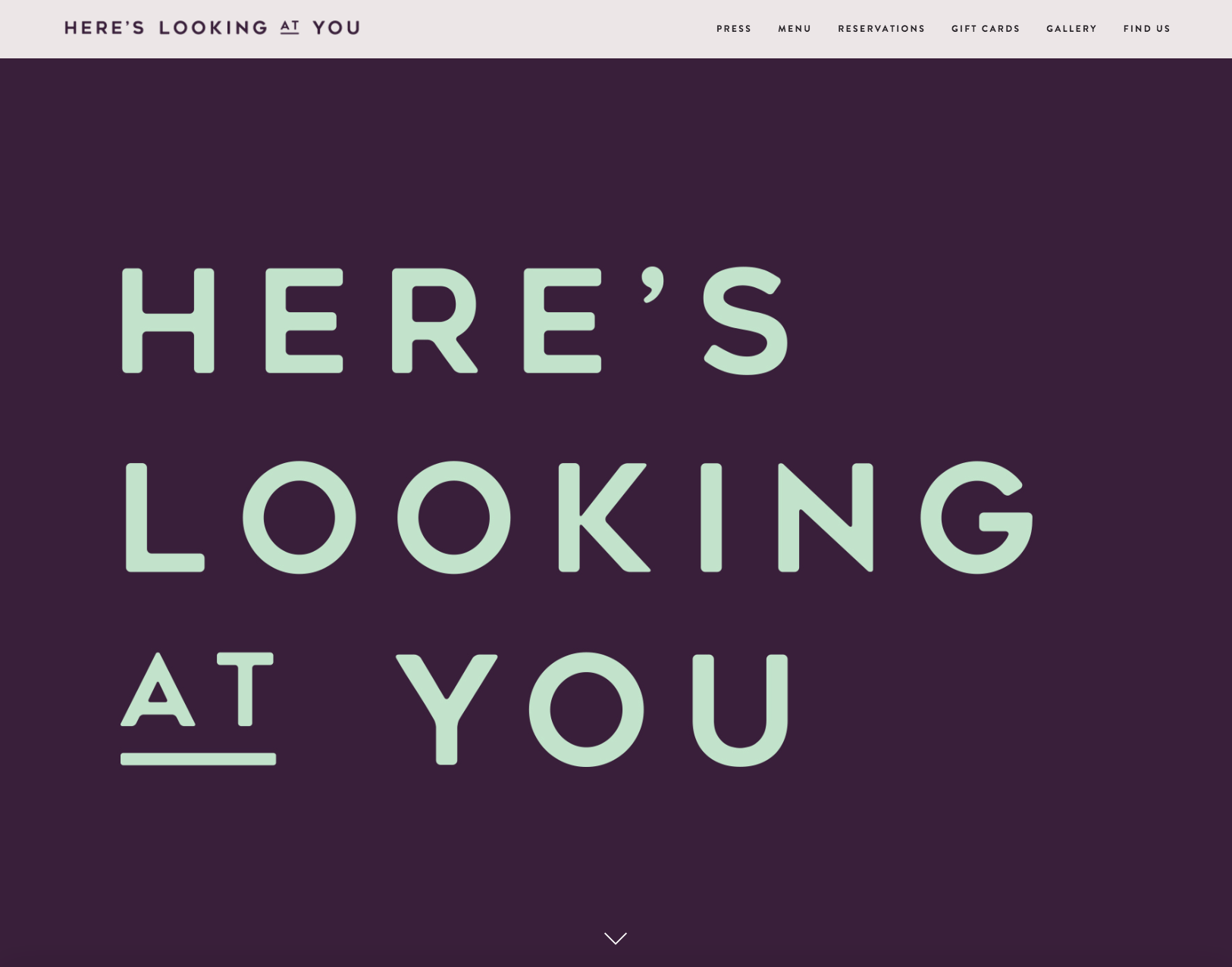
Here’s Looking at You has a website that simply does a great job of capturing their brand. The header image, it grabs attention right away with its bold text and vivid color contrast. You will notice that in the gallery, there is an image of their large shop window that looks just like header image. I thought that was cool. They did great by adding a link to a review article right in the middle of the home page. Adding reviews to a website builds trust, which is great for customers.
5. Bestia – http://bestiala.com
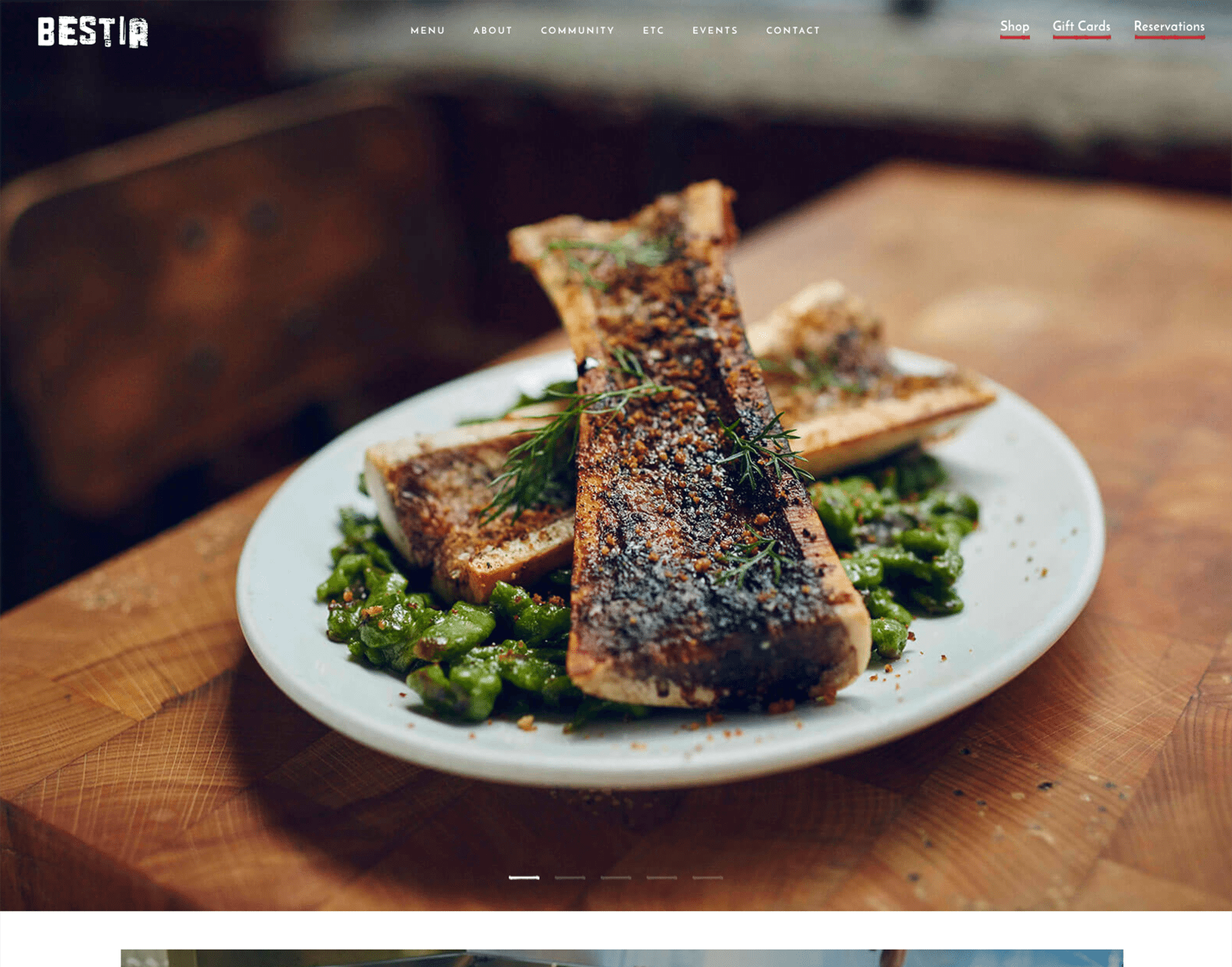
I simply adore this website for Bestia because it really gives you a sense of the culture of the restaurant. It shows the unity between the chefs and employees and gives you a great idea of the food they serve by their image choices, color choices and design style. I also love how their menu is legibly listed and broken up into sections by images describing the section.
6. Alma – http://alma-la.com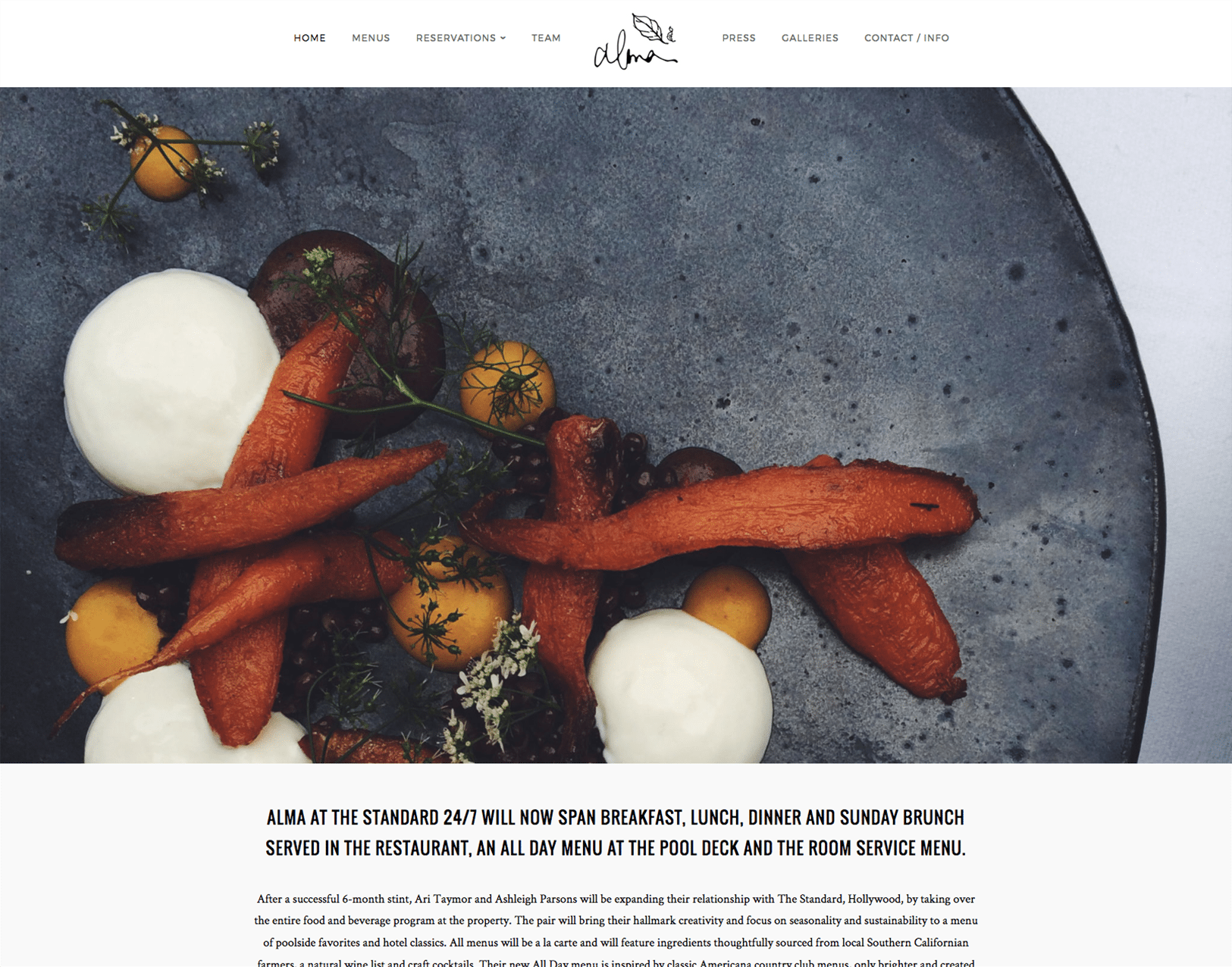
Minimal and modern are the words I would use to describe Alma’s website. The simplicity of the website and the raw and imperfect nature of the photos and food create a very rustic feel. I fell in love with this website because it has a lot of character. I was a is a nice touch including their pup as a member of the team because it shows emotion. Very inviting … I really want to go there.
7. Vallier Bistro – http://vallierbistro.com/en
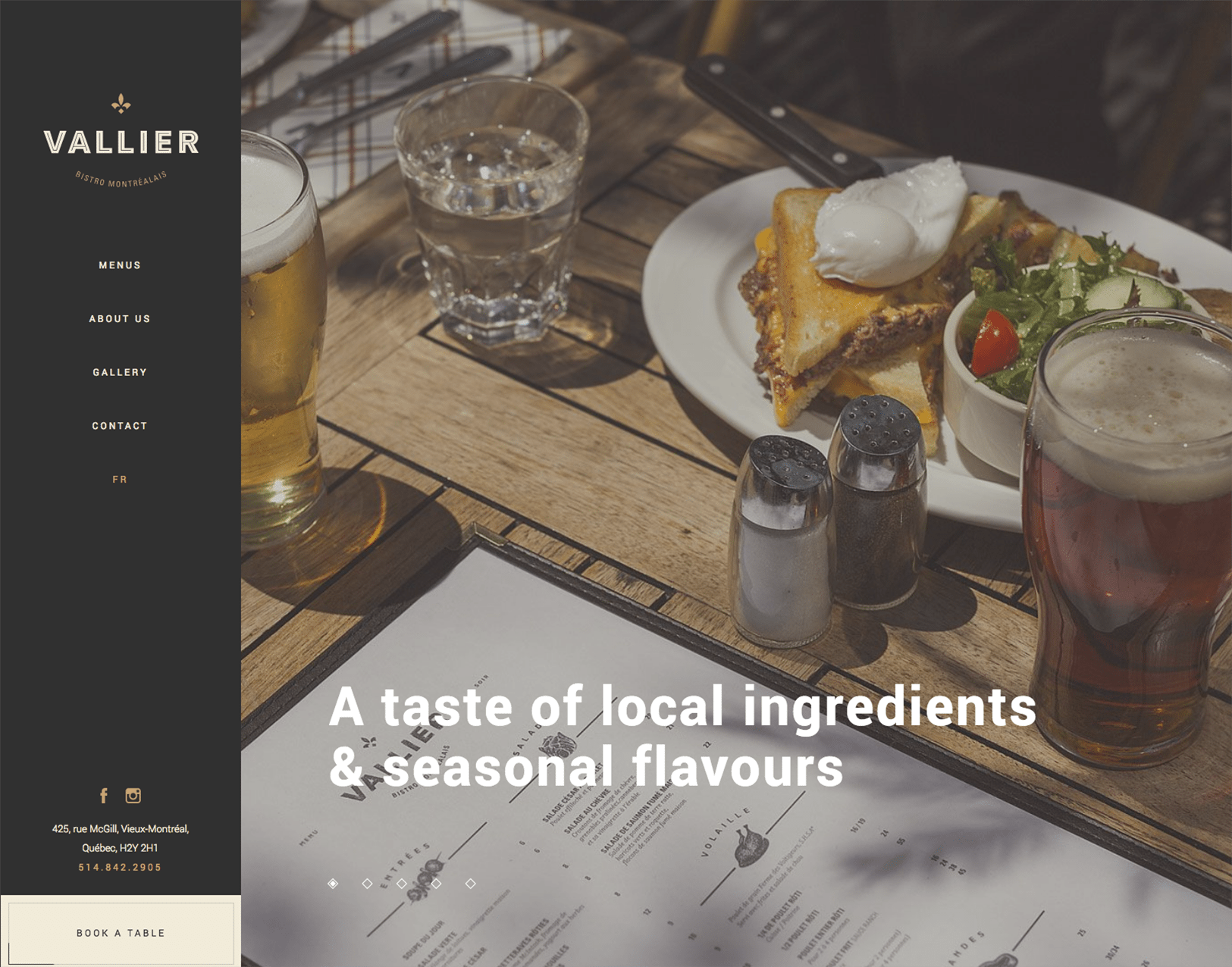
Vallier Bistro is a restaurant located in Canada and it simply exudes high-quality food and a classy atmosphere. Once you get to the website, you are invited with a full-screen zooming slideshow of images of the food and atmosphere of Vallier overlayed by titles giving details about who they are as a restaurant. The one-page website works well with the minimal content because it provides us with straightforward information about them, their food, and how to find them. Seriously, when you think about it, these details are the basics of what customers need to see on a website to make a quick decision on where they want to dine. Overall, straight to the point, beautiful, and classy.
8. Black Bottom Cafe – http://blackbottomcafe.com

Black Bottom Cafe is a restaurant that serves healthy southern food for pick up or delivery. Their colorful images give customers a visual taste of their cooking. I like that they promote southern hospitality with their image choices. The script font in combination with the bold text for their section titles definitely places a lot of emphasis on the sections. Their menu page is laid out very clearly and provides a good amount of detail about their food choices.
9. Mercer Tavern – http://mercertavern.com
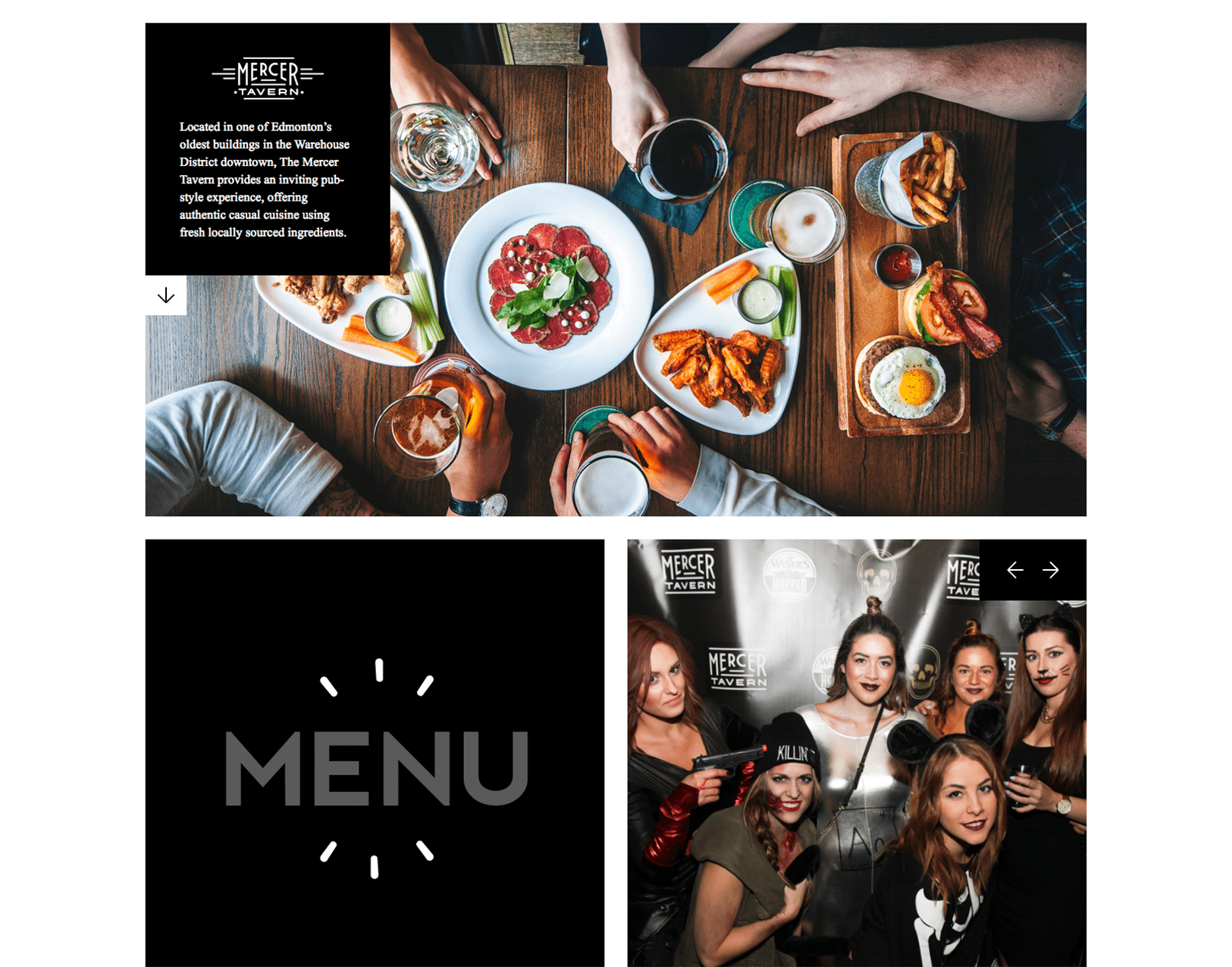
Yeah, yeah, I know I have mentioned in almost each of these reviews how much I love each website but this one here is one that I really, really love. The Mercer Tavern website is just simple. It is a one-page site that uses a grid layout with all the information you need right in front of you. It has a main image, menu, photo gallery, hours, contact information, careers, social and newsletter sign up simply placed on the one-page site. Flashing text is a thing of the past but how they use it on the menu button is attracting and less intimidating.
10. Dukes – http://dukesbrewandque.com
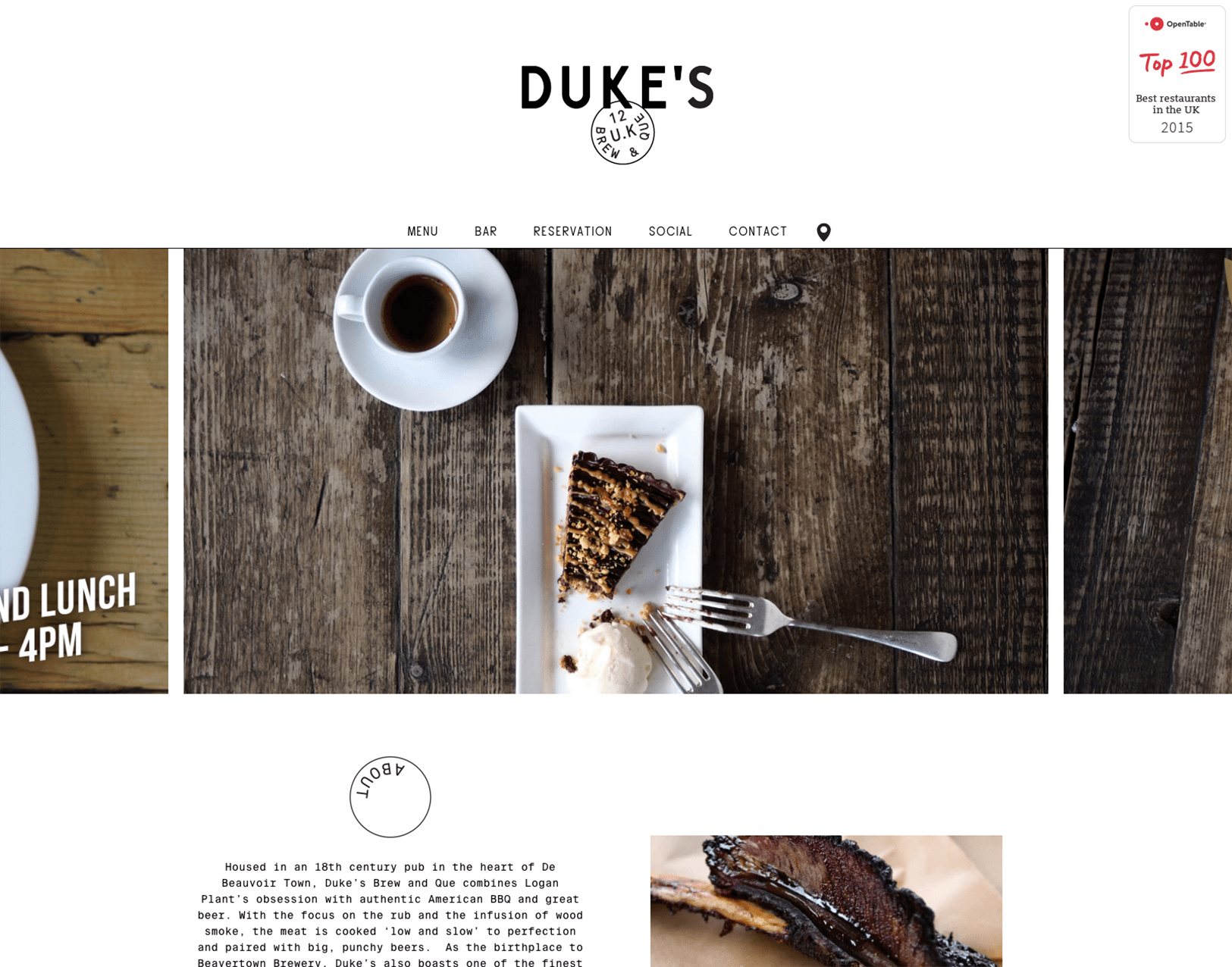
Duke’s is another example of a good one-page website. The monospaced font type gives a hipster feel to the design. I especially like how they integrated their social media into the navigation of the website so it is so easy to find them.
Well folks, that’s all I have for today. I hope these 10 successful restaurant websites were as great of an inspiration for you as it was for me. If after looking at these, you feel that it is time to get your website redesigned or newly designed, I highly recommend discussing this with your web designer or contact me here at ASBA for help. Good luck!
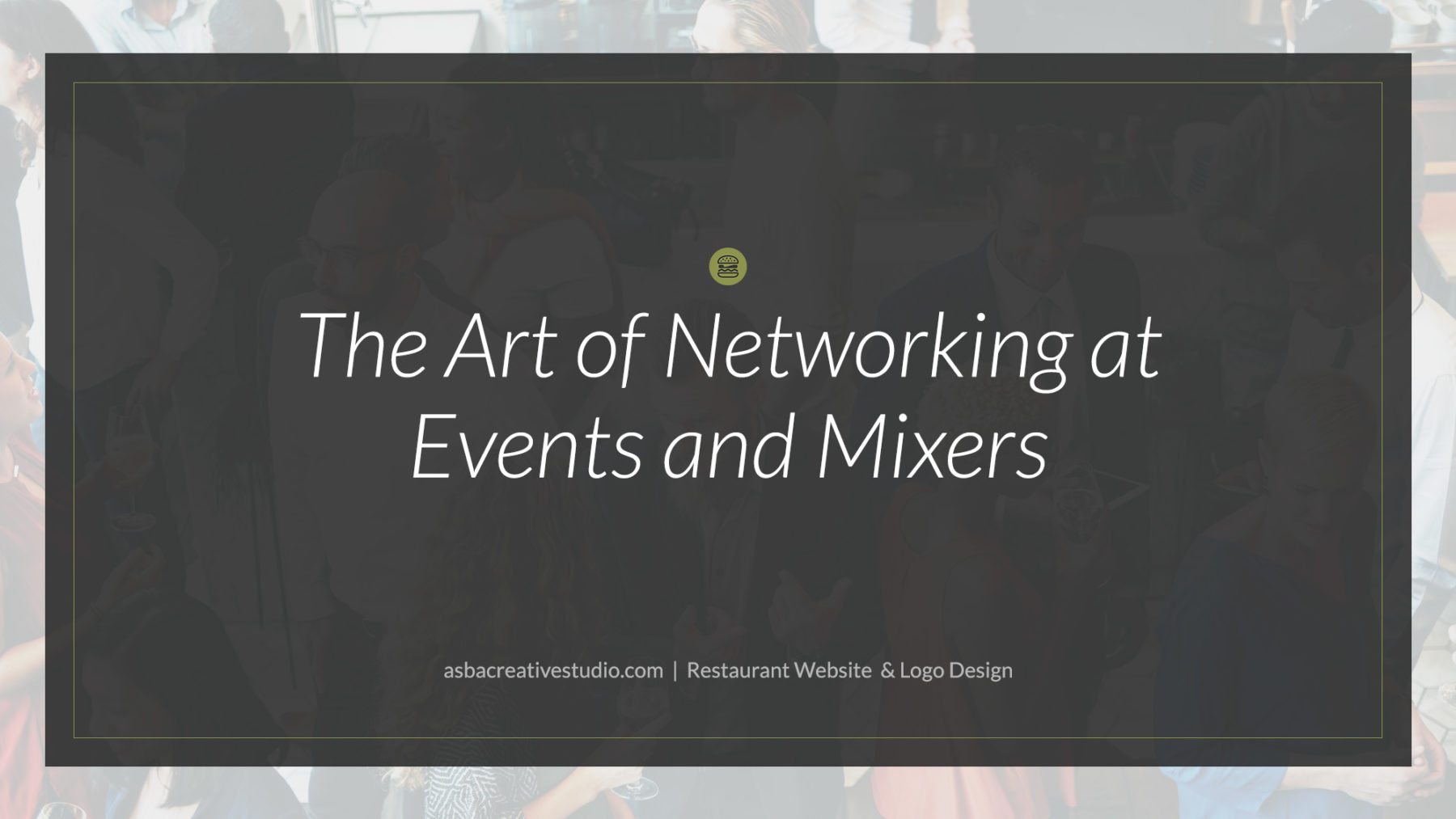
by restaurantspider | Aug 3, 2017 | Updates
Ever been afraid of doing something, but do it anyway due to the benefits? Well, this Monday (7/31/17), I had the pleasure of going to my first mixer held at the Karl Strauss Brewery in downtown Los Angeles. Yay!?
A few months ago, I made a commitment to my customers and myself as a restaurant website designer and signed up with the California Restaurant Association in hopes of getting more insight into the restaurant industry. As part of the perks, I get the opportunity to attend conferences, mixers, events etc. hosted by the association and other related restaurant organizations.
Well, this summer mixer was about networking but for me an opportunity to learn more about the struggles or pain points of the restaurant owner. I was freaked out because just the thought of going up to people I don’t know to introduce myself seemed very foreign to me, even though I meet new people almost every day. Well, to my surprise, the first person I introduced myself to was Fred Glick, the vice president of the Karl Strauss Brewery and his wife Alicia. I didn’t know who Fred was at first because even though he introduced himself, I could not hear a thing, due to the loud music and white noise from conversations between people. Luckily, I didn’t miss the fact that he was a restaurant owner so that got the conversation started. We went right into talking about restaurant websites because he was curious as to what I do for a living. We talked about the needs of a restaurant website and here are some of the points I gathered from him:
Great Images. Restaurants need to hire a professional photographer to take great images of the food served. Lighting is key to a great photo and this is where the photographer brings their expertise.
Email Marketing. Restaurants need to have the option for customers to be able to sign up for their mailing list to get connected with their community.
Social Media. Restaurants need to create social media pages and have social media icons on the website as a way for customers to connect with them.
Online Ordering. Restaurants need to offer online ordering and it’s up to the website designer to make it prominent enough for customers see it, and take advantage of it
This conversation with Fred was a great ice-breaker. It was also great to know that the pointers he gave me were features that I already include in my website packages. Knowing this gave me the confidence to go out there and face the crowd to share my knowledge and gain some more knowledge in the process. Here are a few of the other businesses I met that offer a great service to the restaurant industry:
Heartland: Payment Processing Systems
Goslyn Environmental Systems: Grease Removal
Restaurant Revolution Technologies: Online ordering and take-out systems
Casa Cordoba: Spanish Restaurant located in Montrose CA
Mo-Mo Paradise: Shabu Shabu Restaurant located in Rowland Heights and Torrence, CA
Overall, this was a great experience and I encourage everyone to get out of their comfort zone from time to time for a benefit of their business and personal development.
Tell me about your first experience with networking and your thoughts about the process in the comment box below.
Page 7 of 10« First«...56789...»Last »























